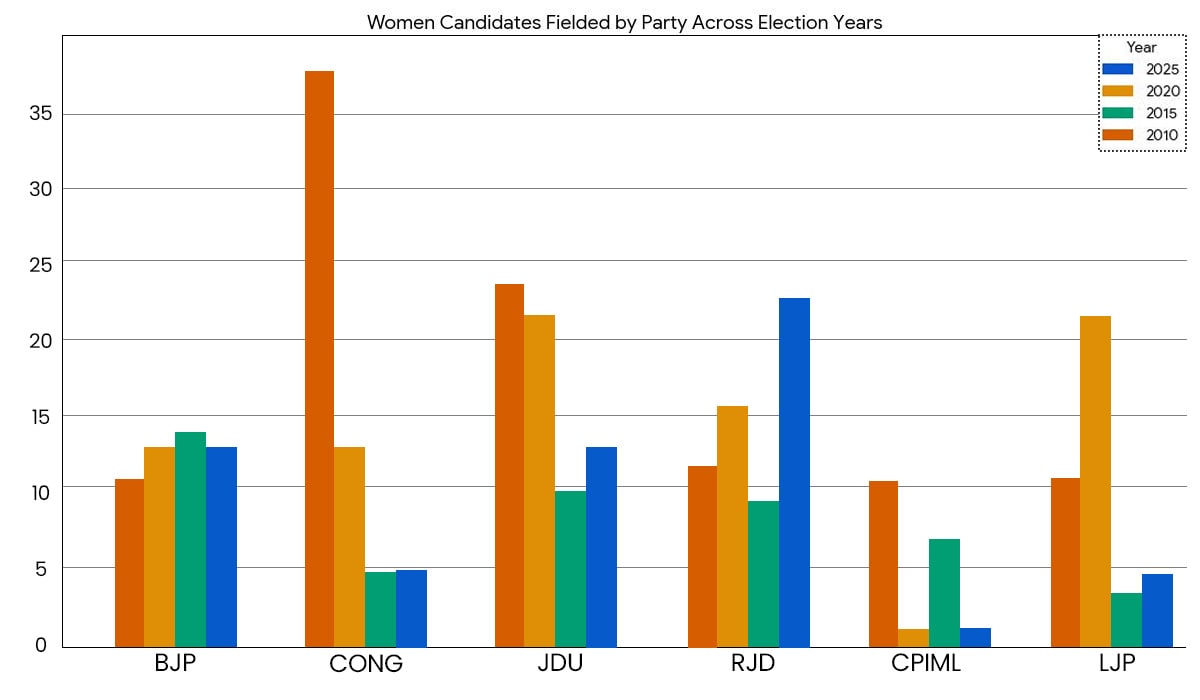
As the electoral battle in Bihar intensifies, political parties continue to reach out to women voters but appear to have forgotten to give tickets to female candidates. In all, 258 women are contesting this election as against 2,357 male candidates.
With 15 days left for the polls, women voters are being considered a key segment, particularly for the National Democratic Alliance (NDA). The state government has also announced various welfare schemes for them. Rs 10,000 was transferred to the bank accounts of 1.25 crore women under the Chief Minister's Women Employment Scheme.
Women have been given 35 per cent reservation in police recruitment and 50 per cent in panchayats and local bodies, with the aim of putting them at the center of decision-making. Low-interest loans for Jeevika Didis, higher allowances for ASHA and Mamata workers, besides priority in employment schemes, further consolidated the NDA's outreach among the women electorate.
On the other hand, the Mahagathbandhan had announced that it will regularise all contractual and outsourced employees and make all Jeevika women permanent government employees with a monthly salary of Rs 30,000 if it comes to power. The "Mai-Bahin Maan Yojana," under which women would receive Rs 2,500 per month starting December 1 for five years, was also promised in the 'Tejashwi Pran' manifesto released earlier this week.
When asked about the lack of female candidates, political parties cite one common reason: winnability.
In this election, the BJP has fielded 13 women candidates, Congress 5, JD(U) 13, RJD 23, Jan Suraaj 25 and the Bahujan Samaj Party leads with 26 female candidates. In the last Assembly election, 26 women MLAs were elected out of 370 women contestants, marking a seven per cent success rate, while male candidates had a winning rate of around 10 per cent.

Data indicates a trend of decline in women's representation across most parties. JD(U) reached its peak in 2020 with 22 women candidates but witnessed a fall in 2025. However, RJD has shown consistent growth, from nine women candidates in 2015 to 23 in 2025. Prashant Kishor's Jan Suraaj Party marked a strong entry this year by fielding the highest number of women candidates - 25. The BJP has maintained almost consistent participation across the last three elections, while CPI-ML saw a major fall after 2015. Congress continues to show a downward trend.

In the 2020 assembly elections, BJP's women candidates had a success rate of 69 per cent, with 9 out of 13 winning from their constituencies. This was followed by RJD with a success rate of 44 per cent, Congress 29 per cent, and JD(U) 27 per cent.
Despite repeated promises to encourage women's political participation, the numbers show a consistent decline, making this election the lowest female representation in Bihar in the last 15 years.
Track Latest News Live on NDTV.com and get news updates from India and around the world

